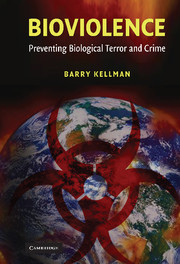Book contents
- Frontmatter
- Contents
- Prologue
- Foreword, by Ronald K. Noble, Interpol Secretary General
- Acknowledgments
- Introduction
- PART I THE BIOVIOLENCE CONDITION AND HOW IT CAME TO BE
- PART II THE GLOBAL STRATEGY FOR PREVENTING BIOVIOLENCE
- 4 Strategic Foundations
- 5 Complication: What Law Enforcers Should Stop
- 6 Improving Resistance through Science
- 7 Public Health Preparedness
- 8 International Nonproliferation
- 9 The Challenge of Global Governance
- Conclusion
- Notes
- Bibliography
- Index
4 - Strategic Foundations
Published online by Cambridge University Press: 27 July 2009
- Frontmatter
- Contents
- Prologue
- Foreword, by Ronald K. Noble, Interpol Secretary General
- Acknowledgments
- Introduction
- PART I THE BIOVIOLENCE CONDITION AND HOW IT CAME TO BE
- PART II THE GLOBAL STRATEGY FOR PREVENTING BIOVIOLENCE
- 4 Strategic Foundations
- 5 Complication: What Law Enforcers Should Stop
- 6 Improving Resistance through Science
- 7 Public Health Preparedness
- 8 International Nonproliferation
- 9 The Challenge of Global Governance
- Conclusion
- Notes
- Bibliography
- Index
Summary
There are scenarios for bioviolence that could deeply destabilize the modern era. To summarize Part I: there are capacities to do harm, and there are people who want to devote those capacities precisely to do harm.
The thesis of Part II is that there are policies that can substantially reduce risks. No proposal, of course, can provide an ironclad guarantee that a bioattack will not happen. It would seem that we will never be completely safe, but there is much that we can do to make us safer. We can pursue these policies in ways that promote the advance of bioscience and that elevate global attention to public health. Absent a prevention strategy, the threats will grow larger and more uncontrollable. Considerable improvement is better than perpetually accruing insecurity.
Prevention strategies are controversial because the limits of these strategies are uncertain. Should broad policy sectors involving health and science be bent to the objective of preventing bioviolence, an as-yet unrealized threat? The answer must be clear: preventing bioviolence is one part of a policy mélange, important but not an exclusive priority. Whatever actions are to be taken must not only improve security from biothreats, they must also promote (or at least not encumber) other values and aspirations. Putting this point more bluntly, not everything that can conceivably be done to prevent bioviolence should be undertaken. Not every preventive measure produces benefits that are worth the costs.
- Type
- Chapter
- Information
- BioviolencePreventing Biological Terror and Crime, pp. 87 - 100Publisher: Cambridge University PressPrint publication year: 2007



